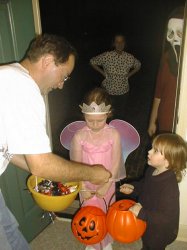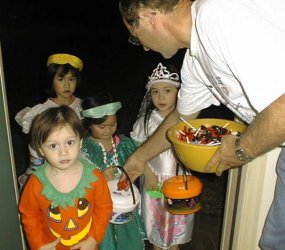Trick or treat!Ring-ring! Knock, knock! I hear simultaneously my doorbell being rung and knocking on my door at the same time. Someone is waiting outside for me very impatiently. Who could be at my house on this dark October night? When I open the door, I hear a chorus of ”Trick or treat!” from many small voices. To my delight, I see many small children dressed in ingenious costumes gathered on my doorstep. Each child carries a large bag or other container in their hands. I compliment them on the cleverness of their disguises, then place pieces of candy in each child’s bag. Each child thanks me in turn. Task completed, their accompanying parents depart to lead them to the house next to mine. This scene is repeated in nearly every neighborhood in the United States each October 31st. It is a night we call ”Halloween,” and it is probably the most treasured holiday by our children after Christmas. Many cultures have a special day dedicated to the memories or ghosts of the dead. Mexico has a ”Day of the Dead,” celebrating loved relatives that have passed from this life. The American version originates from a celebration called ”All Hallow’s Eve.” Now it is simply called Halloween. Instead of honoring dead relatives, our Halloween is associated with ghosts, demons, and the supernatural. Originally, children saying ”Trick or treat!” meant the resident should either perform a magic trick for them or give them a treat. Nowadays, all children expect to receive candy, and they would be very surprised if a person only performed a magic trick for them. Because I am a dentist, I did not favor giving children candy. One year I gave them toothbrushes imprinted with my office name. This was not very popular! I found many toothbrushes thrown in my yard the following morning! So the next year, I resumed giving candy treats to the neighbor children on Halloween. Children usually stop trick-or-treating about age 12 or 13. What do older children do on Halloween night? Get into trouble, that is what. Halloween is also an occasion for playing mischievous tricks on neighbors, especially ones that have been unkind to neighborhood children in the last year. A person who hides in his house and does not give candy to children might get eggs thrown at his door or car, or his trees decorated by toilet paper! Adults may attend parties on Halloween. Usually the adults dress in scary disguises. A favorite game for any Halloween party is ”bobbing for apples.” A large container is filled with water, then apples are set afloat. People put their faces in the cold water, trying to capture an apple with only their teeth. This is always amusing to watch! To get one’s family in the mood for Halloween, a visit to a Halloween ”haunted house” is a good thing to do. A charity might fill a house with all sorts of frightening things. The house will be very dark, perhaps lit only by candles. There might be organ music played in a minor key. People will pretend that they are dead, then suddenly arise to frighten when you are not prepared. Screams will come out of nowhere. Some people might hide and come out of closets with axes or chainsaws. Fake spiders may drop down from the ceiling. You will know the night is a success when your children are so scared that they cannot go to sleep that night! So you see, we have Halloween can mean a lot of fun for both adults and children. Here are photos of Trick-or-treaters of my neighborhood this year. 

english@centrum.cz |